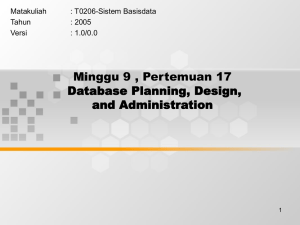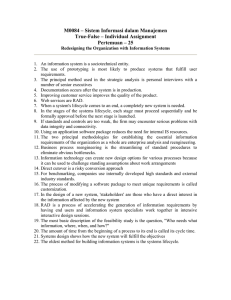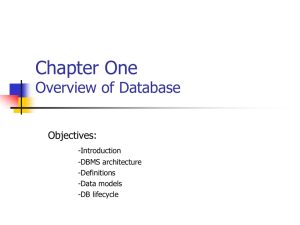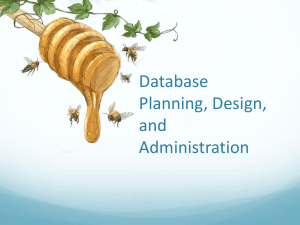Matakuliah : <<M0094>>/<<Pengantar Sistem Basis Data>> Tahun : <<2005>>
advertisement
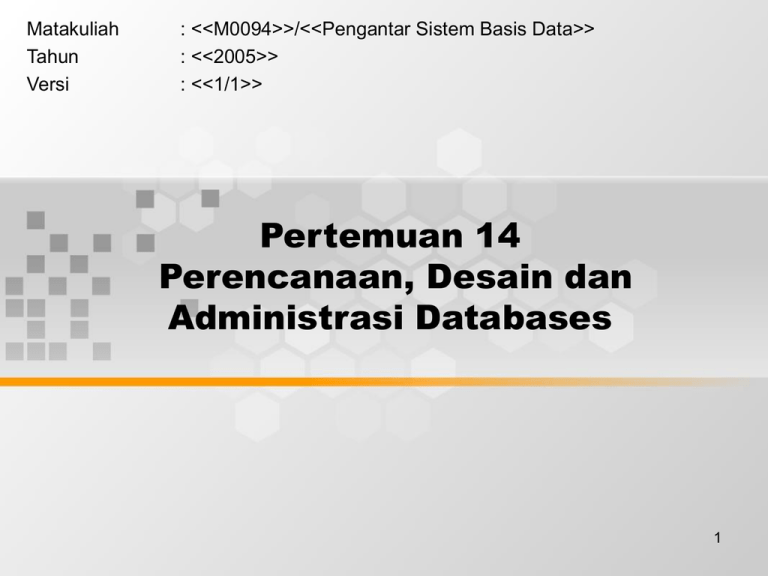
Matakuliah Tahun Versi : <<M0094>>/<<Pengantar Sistem Basis Data>> : <<2005>> : <<1/1>> Pertemuan 14 Perencanaan, Desain dan Administrasi Databases 1 Learning Outcomes Pada akhir pertemuan ini, diharapkan mahasiswa akan mampu : • Mahasiswa dapat Menguraikan tahap tahap dalam daur hidup pengembangan database 2 Outline Materi • Phase dalam perancanaan dan desain database • Daur hidup pengembangan database • Database desain : konseptual, logikal dan physical desain 3 Chapter 9 Database Planning, Design, and Administration Transparencies 4 Chapter 9 - Objectives Main components of an information system. Main stages of database application lifecycle. Main phases of database design: conceptual, logical, and physical design. Benefits of CASE tools. How to evaluate and select a DBMS. Distinction between data administration and database administration. Purpose and tasks associated with data administration and database administration. 52 Software Depression Last few decades have seen proliferation of software applications, many requiring constant maintenance involving: – correcting faults, – implementing new user requirements, – modifying software to run on new or upgraded platforms. Effort spent on maintenance began to absorb resources at an alarming rate. 6 Software Depression As – – – – – a result, many major software projects were late, over budget, unreliable, difficult to maintain, performed poorly. In late 1960s, led to ‘software crisis’, now refer to as the ‘software depression’. 7 Software Depression Major reasons for failure of software projects includes: - lack of a complete requirements specification; - lack of appropriate development methodology; - poor decomposition of design into manageable components. Structured approach to development was proposed called information systems lifecycle. 8 Information System Resources that enable collection, management, control, and dissemination of information throughout an organization. Database is fundamental component of I.S., and its development/usage should be viewed from perspective of the wider requirements of the organization. 9 Database Application Lifecycle Database System planning definition Requirements Database DBMS collection and analysis design selection (optional) 10 Database Application Lifecycle Application design Prototyping (optional) Implementation Data conversion and loading Testing Operational maintenance. 11 Stages of the Database Application Lifecycle 12 Database Planning Management activities that allow stages of database application lifecycle to be realized as efficiently and effectively as possible. Must be integrated with overall IS strategy of the organization. 13 Database Planning – Mission Statement Mission statement for the database project defines major aims of database application. Those driving database project normally define the mission statement. Mission statement helps clarify purpose of the database project and provides clearer path towards the efficient and effective creation of required database application. 14 Database Planning – Mission Objectives Once mission statement is defined, mission objectives are defined. Each objective should identify a particular task that the database must support. May be accompanied by some additional information that specifies the work to be done, the resources with which to do it, and the money to pay for it all. 15 Database Planning Database planning should also include development of standards that govern: – – – – how data will be collected, how the format should be specified, what necessary documentation will be needed, how design and implementation should proceed. 16 System Definition Describes scope and boundaries of database application and the major user views. User view defines what is required of a database application from perspective of: – a particular job role (such as Manager or Supervisor) or – enterprise application area (such as marketing, personnel, or stock control). 17 System Definition Database application may have one or more user views. Identifying user views helps ensure that no major users of the database are forgotten when developing requirements for new application. User views also help in development of complex database application allowing requirements to be broken down into manageable pieces. 18 Representation of a Database Application with Multiple User Views 19 Requirements Collection and Analysis Process of collecting and analyzing information about the part of organization to be supported by the database application, and using this information to identify users’ requirements of new system. 20 Requirements Collection and Analysis Information is gathered for each major user view including: – a description of data used or generated; – details of how data is to be used/generated; – any additional requirements for new database application. Information is analyzed to identify requirements to be included in new database application. 21 Requirements Collection and Analysis Another important activity is deciding how to manage database application with multiple user views. Three main approaches: – centralized approach; – view integration approach; – combination of both approaches. 22 Requirements Collection and Analysis Centralized approach – Requirements for each user view are merged into a single set of requirements. – A global data model is created based on the merged requirements (which represents all user views). 23 Centralized Approach to Managing Multiple User Views 24 Requirements Collection and Analysis View integration approach – Requirements for each user view are used to build a separate data model. 25 Requirements Collection and Analysis Data model representing single user view is called a local data model, composed of diagrams and documentation describing requirements of a particular user view of database. Local data models are then merged to produce a global data model, which represents all user views for the database. 26 View Integration Approach to Managing Multiple User Views 27 Database Design Process of creating a design for a database that will support the enterprise’s operations and objectives. 28 Database Design Major aims: – Represent data and relationships between data required by all major application areas and user groups. – Provide data model that supports any transactions required on the data. – Specify a minimal design that is appropriately structured to achieve stated performance requirements for the system (such as response times). 29 Database Design Approaches – – – – include: Top-down Bottom-up Inside-out Mixed 30 Database Design Main purposes of data modeling include: – to assist in understanding the meaning (semantics) of the data; – to facilitate communication about the information requirements. Building data model requires answering questions about entities, relationships, and attributes. 31 Database Design A data model ensures we understand: - each user’s perspective of the data; - nature of the data itself, independent of its physical representations; - use of data across user views. 32 Criteria to Produce an Optimal Data Model 33 Database Design Three phases of database design: – Conceptual database design – Logical database design – Physical database design. 34 Conceptual Database Design Process of constructing a model of the information used in an enterprise, independent of all physical considerations. Data model is built using the information in users’ requirements specification. Source of information for logical design phase. 35 Logical Database Design Process of constructing a model of the information used in an enterprise based on a specific data model (e.g. relational), but independent of a particular DBMS and other physical considerations. Conceptual data model is refined and mapped on to a logical data model. 36 Physical Database Design Process of producing a description of the database implementation on secondary storage. Describes storage structures and access methods used to achieve efficient access to data. Tailored to a specific DBMS system. 37 Three-Level ANSI-SPARC Architecture and Phases of Database Design 38 << PENUTUP>> Selanjutnya pert 15 SQL View 39
